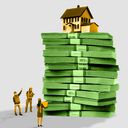"Flippers" now represent a whopping 10% of home sales

One in 10 U.S. homes sold in the first quarter of 2022 was "flipped" — or bought-and-sold within a year by an arms-length buyer — the highest level since 2000.
Why it matters: While the upward march in home prices has turned house-flipping into a blood sport, profit margins are on the decline, reflecting rising mortgage rates and higher labor and material costs.
Driving the news: Home flipping has been on the rise for five straight quarters, according to ATTOM, which runs a national real estate database.
- In the first three months of the year, 114,706 single-family houses and condominiums in the United States were flipped, representing 9.6% of home resale transactions.
- That was up from 6.9% in the fourth quarter of 2021 and 4.9% in the first quarter of last year.
- But the raw profits on those deals were lower than a year ago, and profit margins sank to their lowest point since 2009, ATTOM said.
What they're saying: "The good news for fix-and-flip investors is that demand remains strong from prospective homebuyers," said Rick Sharga, executive vice president of market intelligence for ATTOM.
- “The bad news is that rising mortgage interest rates are beginning to slow down home price appreciation rates, and buyers have become more selective," he added.
- Buyers are "less willing to outbid other buyers for properties they’re interested in," Sharga said, adding, "This is having a predictable impact on profit margins for investors.”
The big picture: Institutional flippers are often considered big villains in the nation's acute housing shortage, in which affordable units and "starter" homes are particularly scarce.
- "From individuals with smartphones and a few thousand dollars, to pensions and private-equity firms with billions, yield-chasing investors are snapping up single-family houses to rent out or flip," the Wall Street Journal reported last year.
- They're "competing for houses with ordinary Americans" and driving up prices, the Journal said.
- “You now have permanent capital competing with a young couple trying to buy a house,” John Burns, a real estate consultant, told the Journal, adding: “That’s going to make U.S. housing permanently more expensive.”
Other factors — like lackluster new-home construction and the rising cost of lumber — have also played a huge role.
- A 2021 Freddie Mac analysis placed the national shortage of housing units at 3.8 million, while a National Association of Realtors report from the same year found an "underbuilding gap" of 5.5 to 6.8 million units since 2001.
Where they're flipping: Phoenix took the flipping prize for the first quarter of 2022: 18.7% of all home sales there were flips.
- Next came Charlotte, N.C. (18%); Tucson, Ariz. (16.2%); Atlanta, Ga. (16.1%); and Jacksonville, Fla. (16%).
Where they're not: Olympia, Wash. had the lowest home-flipping rate of the metro areas analyzed by ATTOM: 4.4%.
- The next runners-up were Portland, Maine (4.6%); Salem, Ore. (4.7%); Syracuse, N.Y. (4.7%); and Davenport, Iowa (4.9%).
By the numbers: While starry-eyed investors continue to fix and flip, their return on investment is dwindling: Typical returns decreased in three-quarters of metro areas, ATTOM said.
- Flipped homes resold for a median price of $327,000 in the first quarter of 2021. That's a gross profit of $67,000 above the median investor purchase price of $260,000, resulting in a 25.8% profit margin.
- But profit margins declined in the first quarter of 2022 from the prior quarter in 73% of the metro areas with enough data to analyze, ATTOM said.
Most investors pay cash for the homes they proceed to flip. Nearly two-thirds of flipped homes in the first quarter — 62.7% — had been purchased by the flippers without financing.
- That's virtually unchanged from the prior quarter (62.9%) and up slightly from 60.9% in the first quarter of 2021.
- As interest rates rise, "cash buyers should be in an even greater position of competitive advantage in the fix-and-flip market,” Sharga said. “It will be interesting to see if the percentage of cash purchases, and purchases made by larger, better capitalized investors, increases over the next few quarters.”
What's next: The fix-and-flip market is expected to cool alongside the broader real estate market as mortgage rates rise, home prices soften, and labor and home-building materials continue to be in tight supply.